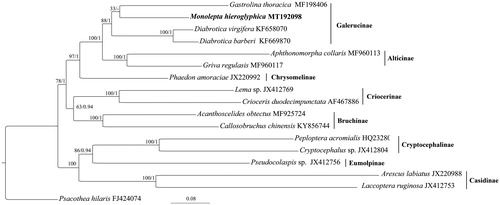Abstract
In this study, the complete mitochondrial genome of Monolepta hieroglyphica (Motschulsky) was sequenced. The M. hieroglyphica mitogenome is a circular, double-stranded molecule, with 15,963 bp in length. The typical 37 mitochondrial genes (13 PCGs, 22 tRNAs, and 2 rRNAs) and an A + T-rich region are included. Gene content and arrangement are identical to that of the ancestral insect Drosophila yakuba. Phylogenetic analyses based on the combined 13 protein-coding genes consistently recovered three clades depicting the subfamily-level relationships within Chrysomelidae as reported in a previous study. Monolepta hieroglyphica is nested into the monophyletic Galerucinae, which is demonstrated first based on mitochondrial genome data.
The Chrysomelidae (leaf beetles), includes approximately 40,000 described species, is one of the largest families of Coleoptera (Leschen and Beutel, Citation2014). A great number of leaf beetles are important agricultural pests causing huge economic loss in crops and vegetable production. Mitochondrial genome (mitogenome) harbors the whole genetic information of an organelle mitochondrion and have been extensively used in systematics, population genetics and molecular evolutionary studies (Cameron Citation2014). The Monolepta hieroglyphica (Motschulsky), belonging to the Galerucinae of Chrysomelidae, is an omnivorous agricultural pest with a wide distribution in China. In this study, we first report the complete mitogenome of the M. hieroglyphica (Motschulsky), aiming to provide genetic basis for future management of this pest and related species.
Adult specimens were collected from Zhoukou City (114°40′47″E, 33°38′38″N) of Henan Province, China. After species identification and extraction of genomic DNA, one library was constructed, and an Illumina Miseq platform was used for sequencing with the strategy of 150 paired-ends. Geneious R10 (Kearse et al., Citation2012) was used to assembly the genome with ‘map to reference’ strategy employing the standard cox1 gene barcodes as the ‘anchor’. Voucher specimens are deposited in the Biology Laboratory of Zhoukou Normal University (accession number: 2019ZK126), China.
The M. hieroglyphica mitogenome (GenBank accession number: MT192098) is a circular, double-stranded molecule, with 15,963 bp in size, and includes typical 37 mitochondrial genes (13 PCGs, 22 tRNAs, and 2 rRNAs) plus an A + T-rich region. Gene content and arrangement are identical to that of the ancestral insect Drosophila yakuba (Clary and Wolstenholme, Citation1985). The nucleotide composition is A 41.1%, G 8.1%, C 11.6, and T 39.2, exhibiting a highly A/T bias as commonly present in insects (Boore, Citation1999).
The total length of 13 PCGs of M. hieroglyphica is 11,129 bp, encoding 3709 amino acids. Most PCGs use the conventional ATN as start codon, with an exception being TTG for the nad1. TAA is used as stop codons in eight PCGs, whereas the incomplete termination codon T is recognized in nad6 and nad5, and the TAG is used in cob, nad1 and nad3. Typically, 22 tRNAs are recognized with the lengths ranging from 61 bp (trnC, trnL1) to 71 bp (trnK, trnV). Two rRNA genes, rrnS and rrnL are recognized with the size of 744 bp and 1272 bp, respectively.
There are 15 overlapping regions ranging from 1 to 8 bp in size. In the overlapping region at atp6 and atp8 junction, a 7-bp motif of ‘ATGATAA’ is actually a common feature for even all insects. As the largest non-coding region, the A + T-rich region is 1410 bp long, and includes two easily recognized blocks: one consisting of six 42 bp repeated units and the other consisting of five 10 bp repeated units. Among other six non-coding regions ranging from 1 to 17 bp in size, the one between trnS2 and nad1 is routinely recognized with the presence of the ‘ATACTAA’ in Coleoptera.
Phylogenetic trees () recovered the M. hieroglyphica as a member of the monophyletic Galerucinae. Besides, three clades depicting the subfamily-level relationships within Chrysomelidae were recovered as reported in Nie et al. (Citation2020). They are the chrysomeline clade (Chrysomelinae, Galerucinae, and Alticnae), the eumolpine clade (Cassidinae, Eumolpinae, Cryptocephalinae), and the sagrine clade (Criocerinae and Bruchinae).
Figure 1. Phylogenetic tree obtained from maximum likelihood analysis based on the dataset consisting of 13 PCGs. The species with newly sequenced mitogenome was emphasized in bold. Numbers separated by a slash on node are bootstrap value for maximum likelihood analysis and posterior probability for Bayesian analysis.

Disclosure statement
No potential conflict of interest was reported by the author(s).
Additional information
Funding
References
- Boore JL. 1999. Animal mitochondrial genomes. Nucleic Acids Res. 27(8):1767–1780.
- Cameron SL. 2014. Insect mitochondrial genomics: implications for evolution and phylogeny. Annu Rev Entomol. 59(1):95–117.
- Clary DO, Wolstenholme DR. 1985. The ribosomal RNA genes of Drosophila mitochondrial DNA. Nucl Acids Res. 13(11):4029–4045.
- Kearse M, Moir R, Wilson A, Stones-Havas S, Cheung M, Sturrock S, Buxton S, Cooper A, Markowitz S, Duran C, et al. 2012. Geneious basic: an integrated and extendable desktop software platform for the organization and analysis of sequence data. Bioinformatics. 28(12):1647–1649.
- Leschen RAB, 2014. and, Beutel RG. Handbook of zoology, band 4: Arthropoda: Insecta, Teilband/Part 40: Coleoptera, beetles, morphology and systematics (phytophaga), Vol. 3. Berlin: Walter de Gruyter.
- Nie RE, Andújar C, Gómez-Rodríguez C, Bai M, Xue HJ, Tang M, Yang CT, Tang P, Yang XK, Vogler AP. 2020. The phylogeny of leaf beetles (Chrysomelidae) inferred from mitochondrial genomes. Syst Entomol. 45(1):188–204. ]
